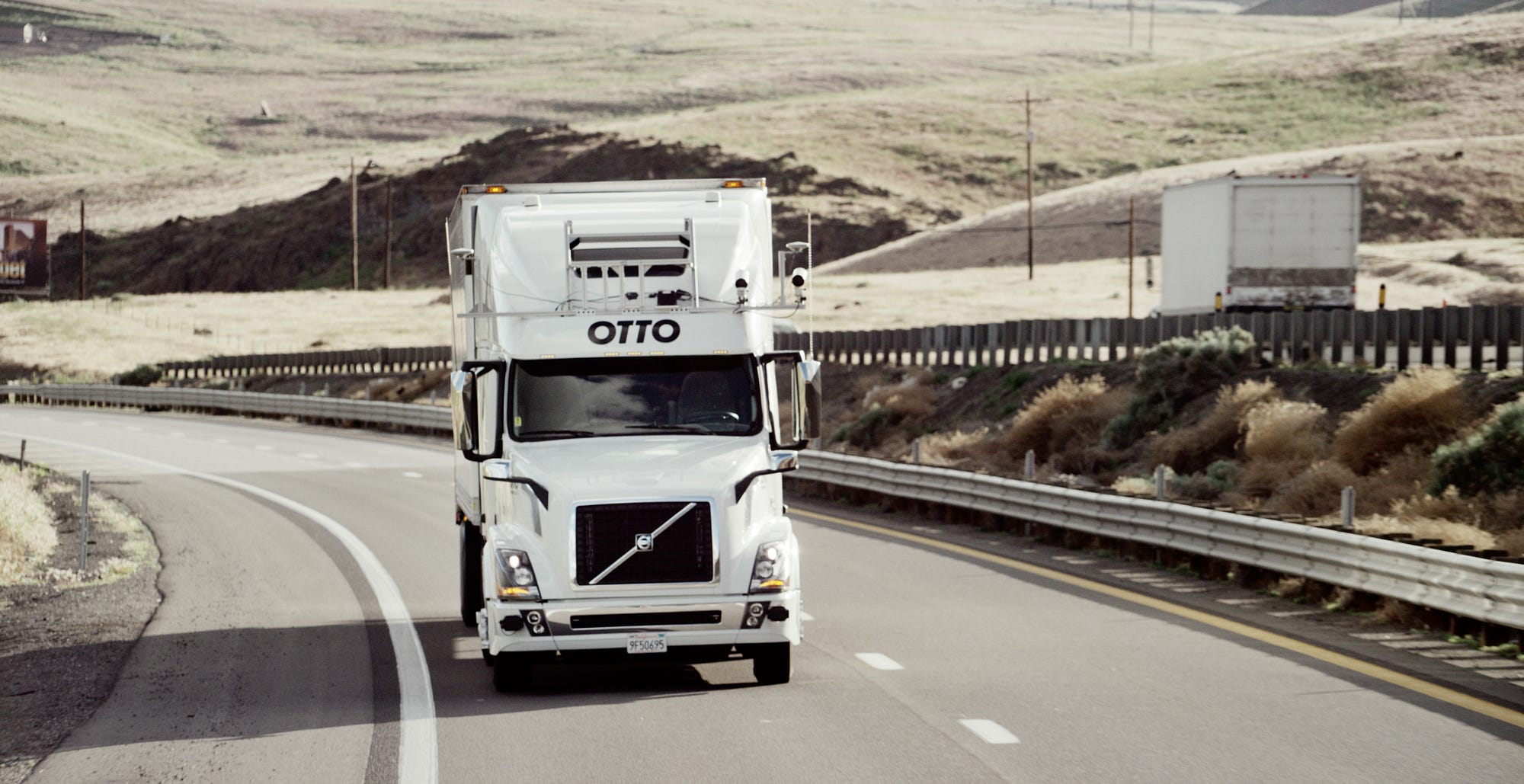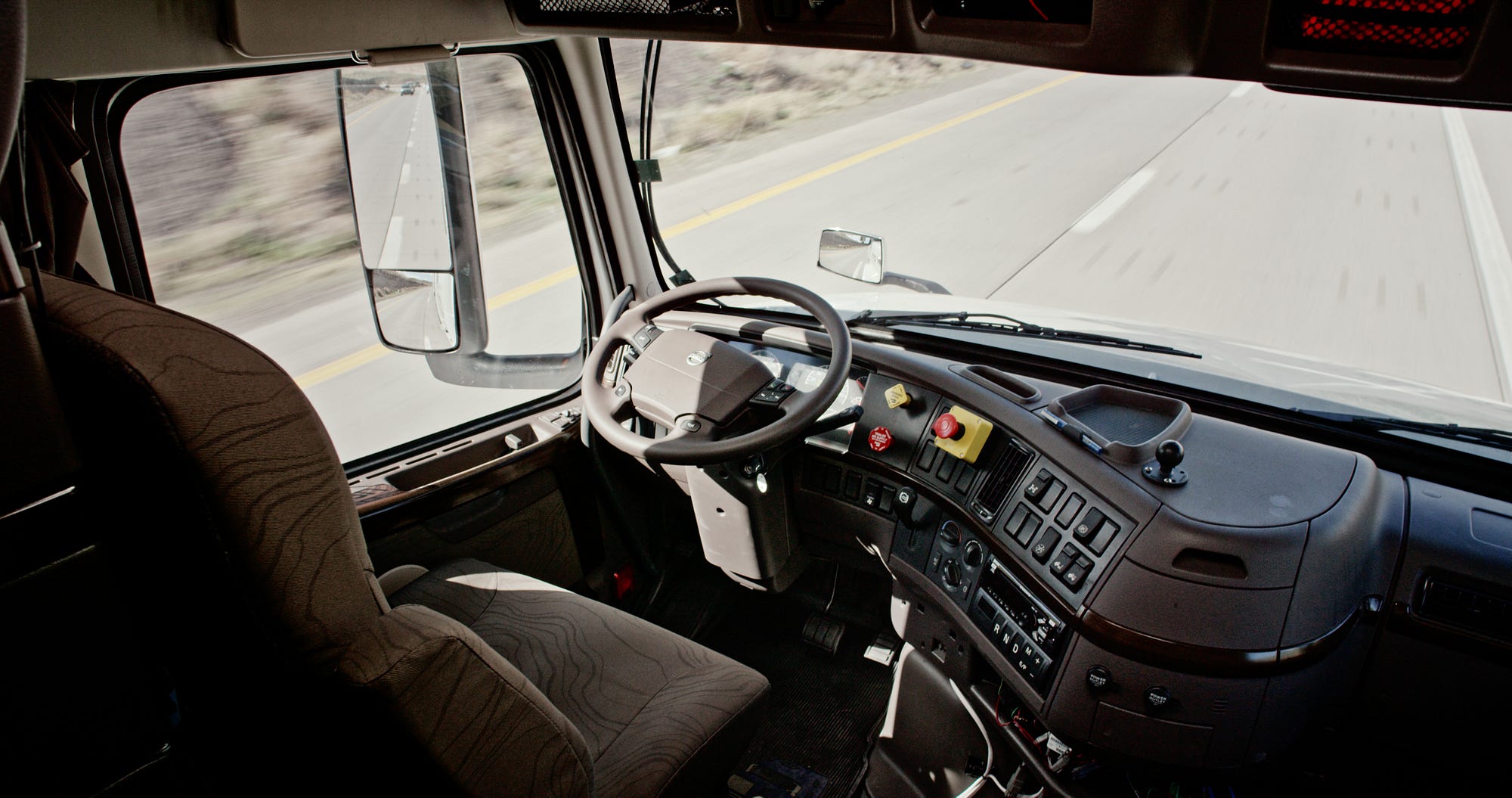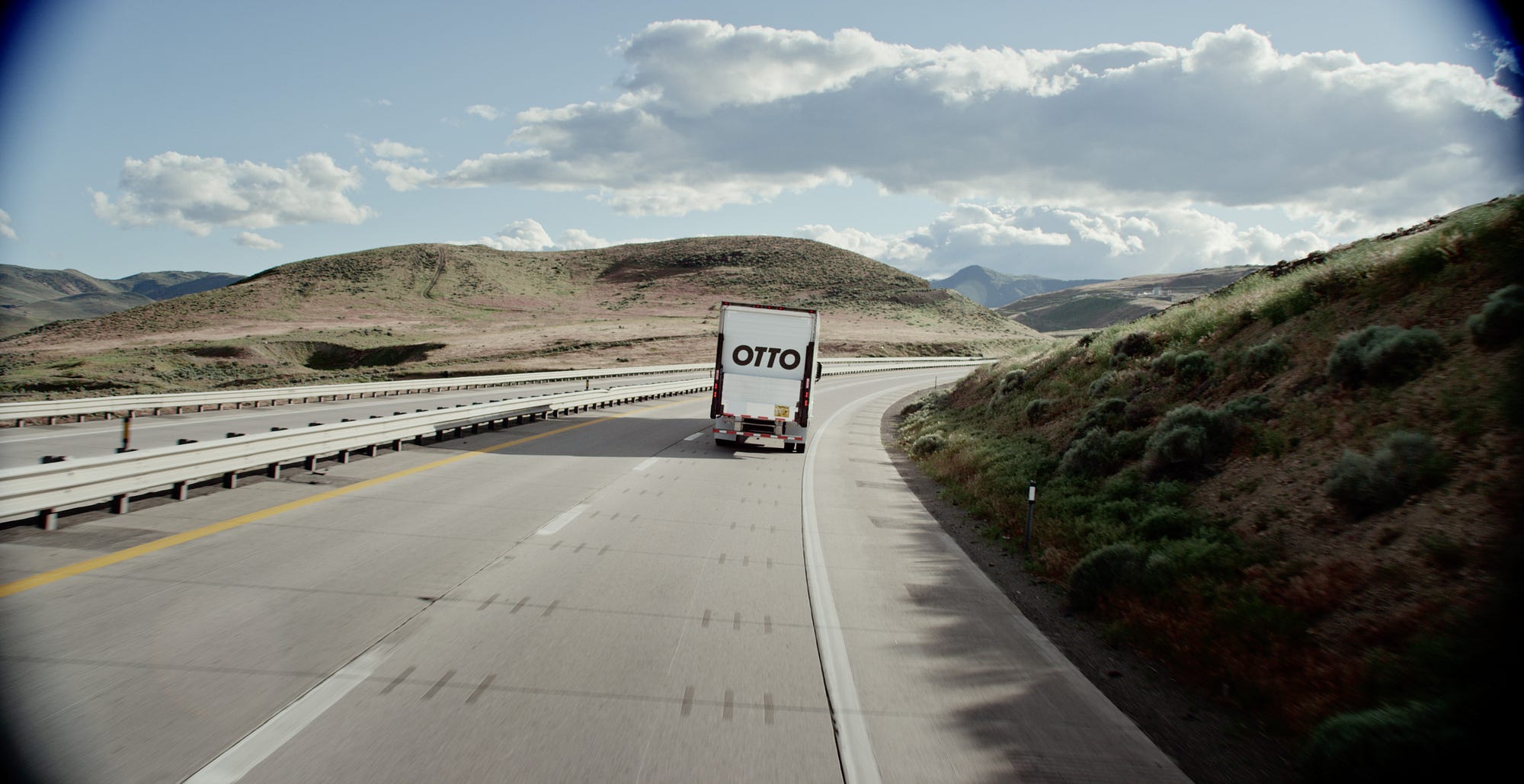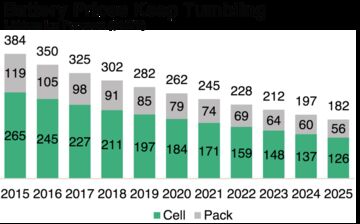As reported by Backchannel: It could be the plot of an Ocean’s Eleven movie: A team of daring engineers heads to the wilds of Nevada to create a dazzling spectacle, defy officials, and walk off with a $680 million jackpot.
In May of this year, Otto unveiled a video of an 18-wheeler thundering down a freeway with no one at the wheel. The San Francisco-based startup had retrofitted a freight truck with lidar, video cameras, radar, and other sensors, enabling it to operate “completely driverless without a driver in the backseat,” according to co-founder Lior Ron at the time.
Even Google, which had been developing self-driving cars for eight years, still insists on having a human in the driving seat should anything go wrong. That a tiny startup emerging from stealth mode could confidently demonstrate an autonomous big rig on a public interstate with no one in the front seats suggested Otto’s technology was really special.
Within just a couple of months, ride-sharing unicorn Uber had acquired the fledgling Otto in exchange for 1 percent of the company’s stock (representing $680 million) and 20 percent of any future self-driving trucking profits — a payout that could exceed a billion dollars for Otto’s founders.
So far, just another Silicon Valley fairytale. Yet Otto’s rapid ascent involved a high-stakes gamble that could have landed the startup in legal hot water, rather than the arms of the world’s biggest transportation network company.
When Otto performed its test drive — the one shown in the May video — it did so despite a clear warning from Nevada’s Department of Motor Vehicles (DMV) that it would be violating the state’s autonomous vehicle regulations. When the DMV realized that Otto had gone ahead anyway, one official called the drive “illegal” and even threatened to shut down the agency’s autonomous vehicle program.
The story of why Otto flouted Nevada’s directive, how it got away with it, and what this means for the future of self-driving regulation stretches back to the dawn of driverless cars.
On May 1, 2012, the world’s first government-run self-driving testtook place on Las Vegas’s famous Strip. In the driver’s seat of a heavily modified 2008 Toyota Prius was Chris Urmson, then the head of Google’s self-driving car project. Next to him sat Anthony Levandowski, the brilliant engineer whose startup 510 Systems had been acquired by Google the previous year, after it had built the tech giant’s first autonomous vehicles.
As the Prius nosed its way past casinos and tourists, its performance was being watched from the back seat by a driving examiner and by Bruce Breslow, then the head of the Nevada DMV. The test was a quick zip around Las Vegas’s surface streets and freeways on a route chosen by Google itself. Despite Urmson having to take control of the vehicle on two occasions, the Prius passed the test with flying colors.
That was hardly surprising, as Nevada’s first autonomous vehicle rules had been proposed and partly shaped by Levandowski himself, with the help of David Goldwater, a lobbyist for Google. The company could now test its self-driving cars anywhere in the state. It was a publicity coup for Nevada, and the first official validation of Google’s vision to replace fallible human drivers with flawless robots.
Over the next four years, however, Google never actually tested its driverless cars in Nevada. And despite welcoming Daimler’s semi-autonomous trucks to the state with a glitzy ceremony in 2015, Nevada’s reputation as a pioneer in autonomous driving ebbed away.
The year 2016 brought some big changes: The energetic Levandowski decided to strike out on his own. “I’m excited about bringing robots into the market, about having the most effect in the world,” he told me. He gathered a handful of colleagues from Google, including Lior Ron, and founded Otto, a startup dedicated to “reimagining transportation—not just improving it.”
Initially, that meant a fully self-driving taxi rather than driverless trucks. In April of this year, Steve Hill, executive director of the Nevada Governor’s Office of Economic Development (GOED), wrote an email to Jude Hurin, the administrator in charge of autonomous vehicle (AV) regulation at the DMV. Backchannel obtained access to this and many more emails and documents under public records legislation.
“Just wanted to let you know that a company is interested in operating completely autonomously, shuttling passengers on a fixed route in Vegas somewhere around the end of this year,” Hill wrote. “David Goldwater represents them and will be contacting your office soon. The company is headed by Anthony Levandowski. All this is confidential.”
The company was Otto, and its plan was to offer driverless rides from Las Vegas’s McCarran airport to the heart of the Strip. Breslow, now director of the state’s Department of Business and Industry, chimed in. “Sounds like the Google project Anthony has wanted to set up for the last four years,” he wrote to Hurin on April 29. “[…] Should be relatively simple to deploy but political backlash from cab industry will occur.”
 Photo credit: Otto
Photo credit: Otto
Less than two weeks later, Goldwater announced a surprising shift in direction. “Otto will have their company launch on Tuesday of next week,” he wrote to Hill on May 12. “[…] They are filming some video of self-driving trucks in Nevada tomorrow for the launch on Tuesday (there is someone in the truck [with] a kill switch.) The filming is being done up in Reno.”
Hurin’s response to Goldwater was swift. “I am concerned….Every company we have dealt with in the past has obtained a test license in our state prior to the media event….Your video is going to produce questions directly to your company and Nevada DMV as to why they do not have a red test plate on the vehicle. I am also going to have Daimler Trucking and others calling me to ask why Otto is allowed to do this when they couldn’t.”
Nevada regulations are clear on this point. Before an autonomous vehicle can be operated on the state’s roads, it must be issued a testing license and special red license plates. It has to be able to capture driving data in case of crashes, have switches to engage and disengage the autonomous systems, and have a way to alert the human operator if it fails.
To obtain a license, Otto would have had to produce evidence of 10,000 miles of previous autonomous operation and submit a truck for a self-driving test, such as the one completed by Google in 2012. It would also need to post a $5 million bond and file reams of paperwork. Even with all those requirements fulfilled, Otto’s demo would need two people seated up front, one of them poised to take over in the event of a failure.
“Without that license you do not have authorization to drive this on our highway in a semi or fully autonomous mode,” wrote Hurin to Goldwater. “Having just a ‘kill switch’ is only part of the safety requirements…but regardless a license is required.”
Goldwater had a different take on the issue, replying, “The truck does have a DOT [Department of Transportation] number, but is not part of a specific trucking company. Therefore, I think the easy answer is it’s not a ‘test truck’ yet. The efforts of Nevada’s leaders are to try to get Otto and similar companies to move here. Most certainly, when the trucks are testing, all laws and regulations will be followed.”
But Hurin was adamant. In an email sent early the next morning, May 13, he warned Goldwater: “It does not matter if you have another State’s license plate or US DOT sticker on it…if they show the vehicle engaging the technology and it implies or is obvious that Nevada is the site that they have engaged the system for the video, then it is a violation of our current AV testing laws.”
In an email to Hurin, Breslow agreed: “I told him [Goldwater] the same thing you did and that he couldn’t just do this.” When Hill, the GOED official, asked whether Otto might be quickly issued a testing permit, Hurin pointed out the impossibility of achieving that literally overnight.
Otto’s founders were faced with a stark choice. They could submit to the DMV and undertake the laborious process of modifying, testing, and licensing their truck. This would likely take a month or more, and could risk their first-mover advantage in driverless trucking. Or the engineers could continue with their test as planned.
They decided to go ahead with the filming, and over the weekend Otto started to emerge from stealth mode. Backchannel was one of the media outlets offered interviews with Otto on Monday, May 16. I heard from Ron about how Otto was going to revolutionize trucking, improve safety, and help the environment.
When I asked Ron where and how the truck had been tested, he said, “We’ve driven a couple of miles completely driverless without a driver in the backseat — not in California, in some other state. We did that on Saturday and will have video assets to show you later today.” Otto’s launch post on Medium confirmed this, saying, “We recently completed an autonomous demo of the technology on a public highway.”
 Photo credit: Otto
Photo credit: Otto
When I watched Otto’s video, I could see its truck, without anyone in the front seats, passing roadside signs on Interstate 80 near Reno. I included that information in my story but wondered how Otto had obtained permission to operate in the state without a license. I subsequently filed a public records request to find out more.
In the meantime, Otto’s launch went smoothly. Terri Albertson, director of the Nevada DMV, noticed the Nevada reference in Backchannel’s story and suggested to Hurin that the department post it on their website. His reply was nothing short of explosive: “Nope!!…They have no license, they are testing no matter what anyone tries to tell me and they have no passengers in the vehicle when current law requires two people….This could very well damage Nevada’s Autonomous ‘Pioneer’ image and our relationships with current OEMs and automated companies who already have a license. Otto is driving these vehicles illegally and without the required $5 million bond that is needed to protect our citizens.”
Hurin even suggested the DMV might walk away from autonomous vehicles altogether. “If push comes to shove we may need to propose that GOED…transfer the AV testing and consumer responsibilities to them and no longer have this under the DMV,” he wrote to Albertson. “I will continue to defend this program and its integrity but if the pressures increase, then it needs to be placed under GOED.” GOED is a pro-growth department focused on attracting and stimulating new business in the state. It has not typically been tasked with overseeing or regulating the industries it serves. But the move did not happen, and no legal action was taken against Otto.
Since then, Otto’s trucks have carried a commercial cargo of beer in Colorado and are due to start testing this week in Ohio, all with the cooperation of state officials.
When I contacted Otto for comment, the company declined to be quoted. It walked back from its claims at the Nevada launch, when it had described its truck as operating “completely driverless without a safety driver in the backseat,” and its drive as “an autonomous demo.” Otto now says its truck did in fact have someone in the cab at the time. Otto also says that the self-driving truck is not an autonomous vehicle at all, at least on Nevada’s roads.
Nevada’s regulations define autonomous technology as “technology which is installed on a motor vehicle and which has the capability to drive the motor vehicle without the active control or monitoring of a human operator.” Because Otto’s truck had an engineer watching from further back in the cab, says the company, it does not count as an autonomous vehicle and thus does not need a permit.
Otto’s argument might not hold up if challenged, says Ryan Calo, a law professor who teaches a class on robotics law and policy at the University of Washington: “One question is whether or not monitoring counts if you’re not in the driver’s seat. Often customs wind up informing the law and the custom here is that other testers, like Google and Tesla, actually have a person sitting in front of the steering wheel.”
Bryant Walker Smith, a professor at the University of South Carolina, points out another difficulty: “If the autonomous law does not apply, what does? If the driver is using a laptop or cellphone, that might run afoul of driver distraction laws. And the highway patrol…could very readily conclude that a big rig without someone at the steering wheel is reckless.”
The DMV’s position remains that Otto’s truck is an autonomous vehicle under Nevada regulations, and that the company violated them. But it doesn’t really matter either way. Bizarrely, the autonomous driving regulations come with no penalties for breaking them.
“The autonomous regulations and policies are living, breathing pieces of this cutting-edge technology,” Hurin told me. “The Department will be submitting another set of AV regulatory amendments in 2017. One of the areas we have already earmarked for these regulations is penalties for this type of violation.”
Over the summer, Hurin kept pressuring Otto to apply for a testing license. Finally, he wrote directly to Levandowski: “We need to find out a specific time when you will be submitting your AV Test Application packet….It has been conveyed to me many times in the past that you are working on this, but to date have received nothing…We look forward to our partnership with Otto, which, as you would agree, must be built on honesty and integrity.”
 Photo credit: Otto
Photo credit: Otto
But Otto was about to pivot once more. The company no longer wanted to test its trucks in Nevada, as it had previously indicated. Instead, in July it applied for a license to operate the state’s first Autonomous Technology Certification Facility (ATCF).
Before any self-driving tech can be sold for use in Nevada, such a facility must issue a certificate stating that it complies with safety requirements, including capturing data prior to collisions, complying with traffic laws, and having the right controls and indicators. The idea is that third-party organizations will take pressure off the state to assess autonomous technologies, providing a smooth route to market.
While Otto was in the process of putting its application together, the company was snapped up by Uber. Levandowski became Uber’s head of self-driving technologies, although Otto would continue to lead the ATCF program in Nevada. Otto had now come full circle, from a tiny startup intent on disrupting taxis in Las Vegas, to maverick autonomous truckers, to a key part of the biggest ride-sharing company on the planet.
The testing facility, a wholly owned subsidiary called Nevada ATCF LLC, received its license from the DMV at the end of September, and is currently hiring staff and remodeling a building in southwest Las Vegas. Otto says that the ATCF will only be used to certify vehicles developed by Otto and Uber.
It is another peculiarity of Nevada’s regulations that a company is not required to test its autonomous vehicles in the state prior to deploying them. The moment Uber licenses its own self-driving trucks or taxis at the ATCF, the vehicles will be ready for public use. “When they decide to sell their technology, they will already be licensed to do so,” Hurin said.
Not making an issue of Otto’s unlicensed demo certainly helped Nevada in the short term. It avoided alienating a leading player in driverless technology and probably helped secure its first autonomous testing facility. But this also came at a cost. Until Nevada clarifies its autonomous vehicle laws and introduces penalties for breaking them, it is difficult to see why any self-driving company should bother with the hassle and expense of certification.
The crumbling of Nevada’s regulatory credibility leaves only California with tough, consumer-focused laws around self-driving cars. In much of the rest of the US, autonomous driving is a free-for-all. Uber taxis are transporting passengers in Pittsburgh, Google’s self-driving prototypes are criss-crossing Texas, and Tesla’s cars are taking over the wheel nationwide, with little official testing or licensing of the technology beforehand.
That might accelerate innovation today, but it means there will be few regulatory tools in place to cope with the many ethical, logistical, and safety challenges that lie further down the self-driving road. And if industry experts can decide to simply skirt the requests of state regulators, the prospects for future regulation look dim.
Otto was nothing less than the perfect Vegas spectacle, equal parts technology, audacity, and showmanship, culminating in an overnight wedding to Uber. As Otto’s founders count their whirlwind winnings, Nevada has shown that well-meaning attempts at keeping tabs on new technology can evaporate just as fast.
In May of this year, Otto unveiled a video of an 18-wheeler thundering down a freeway with no one at the wheel. The San Francisco-based startup had retrofitted a freight truck with lidar, video cameras, radar, and other sensors, enabling it to operate “completely driverless without a driver in the backseat,” according to co-founder Lior Ron at the time.
Even Google, which had been developing self-driving cars for eight years, still insists on having a human in the driving seat should anything go wrong. That a tiny startup emerging from stealth mode could confidently demonstrate an autonomous big rig on a public interstate with no one in the front seats suggested Otto’s technology was really special.
Within just a couple of months, ride-sharing unicorn Uber had acquired the fledgling Otto in exchange for 1 percent of the company’s stock (representing $680 million) and 20 percent of any future self-driving trucking profits — a payout that could exceed a billion dollars for Otto’s founders.
So far, just another Silicon Valley fairytale. Yet Otto’s rapid ascent involved a high-stakes gamble that could have landed the startup in legal hot water, rather than the arms of the world’s biggest transportation network company.
When Otto performed its test drive — the one shown in the May video — it did so despite a clear warning from Nevada’s Department of Motor Vehicles (DMV) that it would be violating the state’s autonomous vehicle regulations. When the DMV realized that Otto had gone ahead anyway, one official called the drive “illegal” and even threatened to shut down the agency’s autonomous vehicle program.
The story of why Otto flouted Nevada’s directive, how it got away with it, and what this means for the future of self-driving regulation stretches back to the dawn of driverless cars.
 |
| Otto co-founder Anthony Levandowski |
As the Prius nosed its way past casinos and tourists, its performance was being watched from the back seat by a driving examiner and by Bruce Breslow, then the head of the Nevada DMV. The test was a quick zip around Las Vegas’s surface streets and freeways on a route chosen by Google itself. Despite Urmson having to take control of the vehicle on two occasions, the Prius passed the test with flying colors.
That was hardly surprising, as Nevada’s first autonomous vehicle rules had been proposed and partly shaped by Levandowski himself, with the help of David Goldwater, a lobbyist for Google. The company could now test its self-driving cars anywhere in the state. It was a publicity coup for Nevada, and the first official validation of Google’s vision to replace fallible human drivers with flawless robots.
Over the next four years, however, Google never actually tested its driverless cars in Nevada. And despite welcoming Daimler’s semi-autonomous trucks to the state with a glitzy ceremony in 2015, Nevada’s reputation as a pioneer in autonomous driving ebbed away.
 |
| Otto co-founder Lior Ron |
Initially, that meant a fully self-driving taxi rather than driverless trucks. In April of this year, Steve Hill, executive director of the Nevada Governor’s Office of Economic Development (GOED), wrote an email to Jude Hurin, the administrator in charge of autonomous vehicle (AV) regulation at the DMV. Backchannel obtained access to this and many more emails and documents under public records legislation.
“Just wanted to let you know that a company is interested in operating completely autonomously, shuttling passengers on a fixed route in Vegas somewhere around the end of this year,” Hill wrote. “David Goldwater represents them and will be contacting your office soon. The company is headed by Anthony Levandowski. All this is confidential.”
The company was Otto, and its plan was to offer driverless rides from Las Vegas’s McCarran airport to the heart of the Strip. Breslow, now director of the state’s Department of Business and Industry, chimed in. “Sounds like the Google project Anthony has wanted to set up for the last four years,” he wrote to Hurin on April 29. “[…] Should be relatively simple to deploy but political backlash from cab industry will occur.”
 Photo credit: Otto
Photo credit: OttoLess than two weeks later, Goldwater announced a surprising shift in direction. “Otto will have their company launch on Tuesday of next week,” he wrote to Hill on May 12. “[…] They are filming some video of self-driving trucks in Nevada tomorrow for the launch on Tuesday (there is someone in the truck [with] a kill switch.) The filming is being done up in Reno.”
Hurin’s response to Goldwater was swift. “I am concerned….Every company we have dealt with in the past has obtained a test license in our state prior to the media event….Your video is going to produce questions directly to your company and Nevada DMV as to why they do not have a red test plate on the vehicle. I am also going to have Daimler Trucking and others calling me to ask why Otto is allowed to do this when they couldn’t.”
Nevada regulations are clear on this point. Before an autonomous vehicle can be operated on the state’s roads, it must be issued a testing license and special red license plates. It has to be able to capture driving data in case of crashes, have switches to engage and disengage the autonomous systems, and have a way to alert the human operator if it fails.
To obtain a license, Otto would have had to produce evidence of 10,000 miles of previous autonomous operation and submit a truck for a self-driving test, such as the one completed by Google in 2012. It would also need to post a $5 million bond and file reams of paperwork. Even with all those requirements fulfilled, Otto’s demo would need two people seated up front, one of them poised to take over in the event of a failure.
“Without that license you do not have authorization to drive this on our highway in a semi or fully autonomous mode,” wrote Hurin to Goldwater. “Having just a ‘kill switch’ is only part of the safety requirements…but regardless a license is required.”
Goldwater had a different take on the issue, replying, “The truck does have a DOT [Department of Transportation] number, but is not part of a specific trucking company. Therefore, I think the easy answer is it’s not a ‘test truck’ yet. The efforts of Nevada’s leaders are to try to get Otto and similar companies to move here. Most certainly, when the trucks are testing, all laws and regulations will be followed.”
But Hurin was adamant. In an email sent early the next morning, May 13, he warned Goldwater: “It does not matter if you have another State’s license plate or US DOT sticker on it…if they show the vehicle engaging the technology and it implies or is obvious that Nevada is the site that they have engaged the system for the video, then it is a violation of our current AV testing laws.”
In an email to Hurin, Breslow agreed: “I told him [Goldwater] the same thing you did and that he couldn’t just do this.” When Hill, the GOED official, asked whether Otto might be quickly issued a testing permit, Hurin pointed out the impossibility of achieving that literally overnight.
Otto’s founders were faced with a stark choice. They could submit to the DMV and undertake the laborious process of modifying, testing, and licensing their truck. This would likely take a month or more, and could risk their first-mover advantage in driverless trucking. Or the engineers could continue with their test as planned.
They decided to go ahead with the filming, and over the weekend Otto started to emerge from stealth mode. Backchannel was one of the media outlets offered interviews with Otto on Monday, May 16. I heard from Ron about how Otto was going to revolutionize trucking, improve safety, and help the environment.
When I asked Ron where and how the truck had been tested, he said, “We’ve driven a couple of miles completely driverless without a driver in the backseat — not in California, in some other state. We did that on Saturday and will have video assets to show you later today.” Otto’s launch post on Medium confirmed this, saying, “We recently completed an autonomous demo of the technology on a public highway.”
 Photo credit: Otto
Photo credit: OttoWhen I watched Otto’s video, I could see its truck, without anyone in the front seats, passing roadside signs on Interstate 80 near Reno. I included that information in my story but wondered how Otto had obtained permission to operate in the state without a license. I subsequently filed a public records request to find out more.
In the meantime, Otto’s launch went smoothly. Terri Albertson, director of the Nevada DMV, noticed the Nevada reference in Backchannel’s story and suggested to Hurin that the department post it on their website. His reply was nothing short of explosive: “Nope!!…They have no license, they are testing no matter what anyone tries to tell me and they have no passengers in the vehicle when current law requires two people….This could very well damage Nevada’s Autonomous ‘Pioneer’ image and our relationships with current OEMs and automated companies who already have a license. Otto is driving these vehicles illegally and without the required $5 million bond that is needed to protect our citizens.”
Hurin even suggested the DMV might walk away from autonomous vehicles altogether. “If push comes to shove we may need to propose that GOED…transfer the AV testing and consumer responsibilities to them and no longer have this under the DMV,” he wrote to Albertson. “I will continue to defend this program and its integrity but if the pressures increase, then it needs to be placed under GOED.” GOED is a pro-growth department focused on attracting and stimulating new business in the state. It has not typically been tasked with overseeing or regulating the industries it serves. But the move did not happen, and no legal action was taken against Otto.
Since then, Otto’s trucks have carried a commercial cargo of beer in Colorado and are due to start testing this week in Ohio, all with the cooperation of state officials.
When I contacted Otto for comment, the company declined to be quoted. It walked back from its claims at the Nevada launch, when it had described its truck as operating “completely driverless without a safety driver in the backseat,” and its drive as “an autonomous demo.” Otto now says its truck did in fact have someone in the cab at the time. Otto also says that the self-driving truck is not an autonomous vehicle at all, at least on Nevada’s roads.
Nevada’s regulations define autonomous technology as “technology which is installed on a motor vehicle and which has the capability to drive the motor vehicle without the active control or monitoring of a human operator.” Because Otto’s truck had an engineer watching from further back in the cab, says the company, it does not count as an autonomous vehicle and thus does not need a permit.
Otto’s argument might not hold up if challenged, says Ryan Calo, a law professor who teaches a class on robotics law and policy at the University of Washington: “One question is whether or not monitoring counts if you’re not in the driver’s seat. Often customs wind up informing the law and the custom here is that other testers, like Google and Tesla, actually have a person sitting in front of the steering wheel.”
Bryant Walker Smith, a professor at the University of South Carolina, points out another difficulty: “If the autonomous law does not apply, what does? If the driver is using a laptop or cellphone, that might run afoul of driver distraction laws. And the highway patrol…could very readily conclude that a big rig without someone at the steering wheel is reckless.”
The DMV’s position remains that Otto’s truck is an autonomous vehicle under Nevada regulations, and that the company violated them. But it doesn’t really matter either way. Bizarrely, the autonomous driving regulations come with no penalties for breaking them.
“The autonomous regulations and policies are living, breathing pieces of this cutting-edge technology,” Hurin told me. “The Department will be submitting another set of AV regulatory amendments in 2017. One of the areas we have already earmarked for these regulations is penalties for this type of violation.”
Over the summer, Hurin kept pressuring Otto to apply for a testing license. Finally, he wrote directly to Levandowski: “We need to find out a specific time when you will be submitting your AV Test Application packet….It has been conveyed to me many times in the past that you are working on this, but to date have received nothing…We look forward to our partnership with Otto, which, as you would agree, must be built on honesty and integrity.”
 Photo credit: Otto
Photo credit: OttoBut Otto was about to pivot once more. The company no longer wanted to test its trucks in Nevada, as it had previously indicated. Instead, in July it applied for a license to operate the state’s first Autonomous Technology Certification Facility (ATCF).
Before any self-driving tech can be sold for use in Nevada, such a facility must issue a certificate stating that it complies with safety requirements, including capturing data prior to collisions, complying with traffic laws, and having the right controls and indicators. The idea is that third-party organizations will take pressure off the state to assess autonomous technologies, providing a smooth route to market.
While Otto was in the process of putting its application together, the company was snapped up by Uber. Levandowski became Uber’s head of self-driving technologies, although Otto would continue to lead the ATCF program in Nevada. Otto had now come full circle, from a tiny startup intent on disrupting taxis in Las Vegas, to maverick autonomous truckers, to a key part of the biggest ride-sharing company on the planet.
The testing facility, a wholly owned subsidiary called Nevada ATCF LLC, received its license from the DMV at the end of September, and is currently hiring staff and remodeling a building in southwest Las Vegas. Otto says that the ATCF will only be used to certify vehicles developed by Otto and Uber.
It is another peculiarity of Nevada’s regulations that a company is not required to test its autonomous vehicles in the state prior to deploying them. The moment Uber licenses its own self-driving trucks or taxis at the ATCF, the vehicles will be ready for public use. “When they decide to sell their technology, they will already be licensed to do so,” Hurin said.
Not making an issue of Otto’s unlicensed demo certainly helped Nevada in the short term. It avoided alienating a leading player in driverless technology and probably helped secure its first autonomous testing facility. But this also came at a cost. Until Nevada clarifies its autonomous vehicle laws and introduces penalties for breaking them, it is difficult to see why any self-driving company should bother with the hassle and expense of certification.
The crumbling of Nevada’s regulatory credibility leaves only California with tough, consumer-focused laws around self-driving cars. In much of the rest of the US, autonomous driving is a free-for-all. Uber taxis are transporting passengers in Pittsburgh, Google’s self-driving prototypes are criss-crossing Texas, and Tesla’s cars are taking over the wheel nationwide, with little official testing or licensing of the technology beforehand.
That might accelerate innovation today, but it means there will be few regulatory tools in place to cope with the many ethical, logistical, and safety challenges that lie further down the self-driving road. And if industry experts can decide to simply skirt the requests of state regulators, the prospects for future regulation look dim.
Otto was nothing less than the perfect Vegas spectacle, equal parts technology, audacity, and showmanship, culminating in an overnight wedding to Uber. As Otto’s founders count their whirlwind winnings, Nevada has shown that well-meaning attempts at keeping tabs on new technology can evaporate just as fast.




















